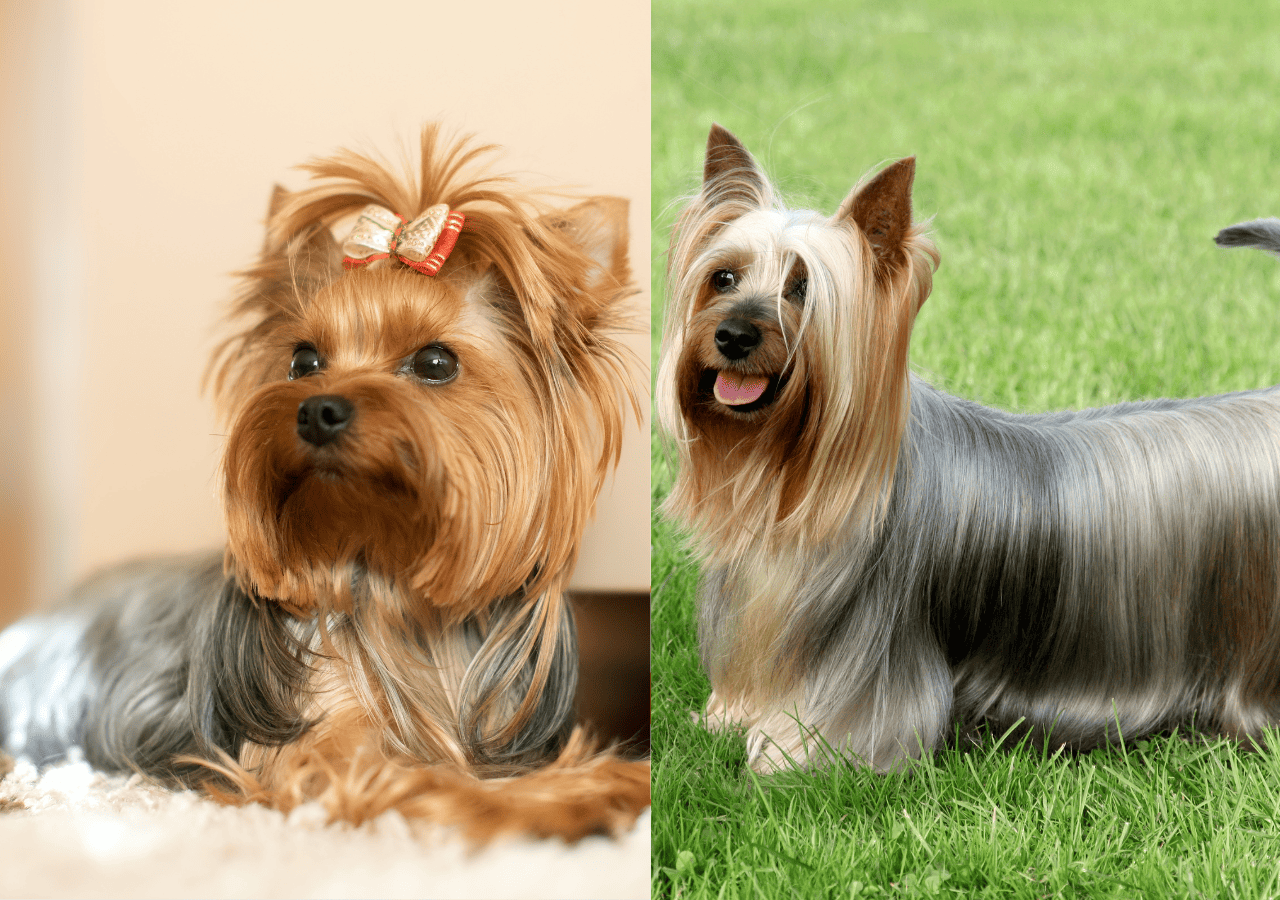When it comes to adorable, pint-sized companions, few breeds tug at the heartstrings quite like the Silky Terrier and Yorkshire Terrier. At first glance, these diminutive dogs might seem indistinguishable, with their glossy coats and perky ears, but a closer look reveals a tapestry of differences that set them apart. Whether you’re a seasoned dog owner or contemplating your first furry friend, understanding these distinctions is key to choosing the right companion for your home and lifestyle. So, who’s better? Read on our Silky Terrier Vs Yorkshire terrier guide!
The Silky Terrier and Yorkshire Terrier, often affectionately known as the Silky and Yorkie, respectively, share more than just a passing resemblance.
Both hail from historical roots deeply embedded in the working-class communities of England, bred originally for the tenacious task of rodent control. Yet, as they’ve evolved from their humble beginnings to become cherished lapdogs, the differences in their breeding have led to unique sets of characteristics that appeal to various preferences and lifestyles.
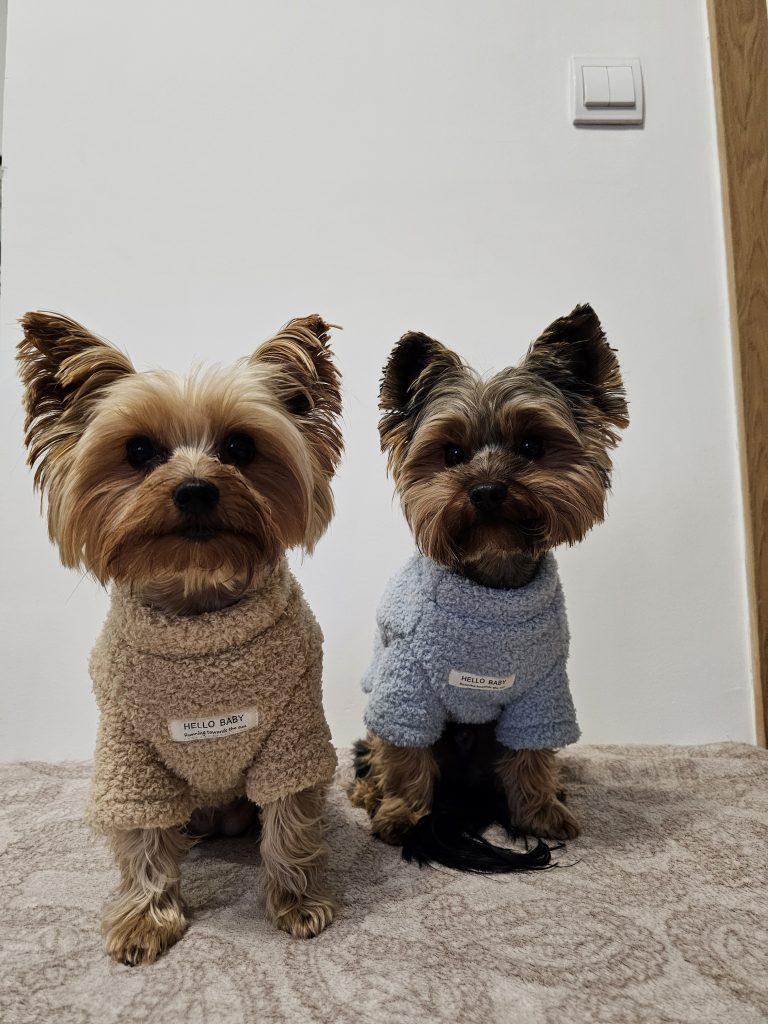
Characteristics of Yorkshire terrier and Silky terrier
The Silky Terrier and Yorkshire Terrier both charm with their elegant appearance and beautiful coats, though notable differences define each breed’s unique look and care requirements.
The Silky Terrier, standing slightly taller at approximately 9 to 10 inches at the shoulder and weighing around 8 to 10 pounds, boasts a more robust frame compared to the dainty Yorkshire Terrier, which typically measures 7 to 8 inches at the shoulder and weighs about 4 to 7 pounds. This difference in size not only influences their physical presence but also has practical implications for their living arrangements and the space they need to thrive.
In terms of their coats, both breeds display a strikingly glossy sheen, yet the texture and grooming needs diverge. The Silky Terrier’s coat, true to its name, is silky and straight, flowing evenly across the body, but it’s prone to tangling and matting if not regularly brushed and maintained.
Conversely, the Yorkshire Terrier’s coat is renowned for its fine, almost human-hair-like quality, which can grow to floor length. This luxurious coat also demands rigorous grooming to keep it in pristine condition, including regular brushing and professional trimming to avoid tangling and maintain its elegant appearance.
READ ALSO: What Is The Best Brush For a Yorkie? Top 4 Picks
Color Variations
Both the Silky Terrier and Yorkshire Terrier share a similar color palette, typically showcasing a beautiful blend of blue and tan. However, the distribution and shade of these colors can vary between the breeds, adding to their distinctive looks. Silky Terriers often have more defined color separation with a rich blue that can range from dark slate to a lighter silver-blue, complemented by tan markings that are more vivid and extensive around the face, legs, and chest.
In contrast, Yorkshire Terriers display a darker steel blue that extends from the back of the neck to the tail, contrasted with a brighter tan on the head, chest, and legs. The intensity of the tan can deepen with age, and the breed standards call for very dark, rich tan colors.
Notably, puppies of both breeds are born with much darker coats that gradually lighten and develop their adult coloration as they mature. This transformation is a delightful process for owners, as it reveals the unique color pattern that characterizes each individual dog. The precise shade and distribution of colors in both breeds are critical aspects of breed standards for show dogs, but for pet owners, these variations contribute to the personal charm and appeal of their furry companions.
Types of Silky Terriers
The Silky Terrier breed, often mistaken for its cousin the Yorkshire Terrier, has carved its own niche in the canine world through a unique blend of characteristics drawn from both the Yorkie and Australian Terrier. This blend has led to the emergence of what some might consider “types” within the breed, largely centered around their historical development and distinctive coat characteristics.
Yorkie Type
Initially, the Silky Terrier was frequently confused with the Yorkshire Terrier, a comparison that persists among the general public even today. This confusion is not unfounded, as the Silky Terrier does indeed share the Yorkie’s elegant, glossy coat, which is silky in texture. However, Beverly Lehnig, a venerable figure in the Silky Terrier community, alongside others like Florence Males, has worked tirelessly to educate the public and judges alike on the distinctiveness of the Silky Terrier. One of the most emphasized distinctions is the breed’s coat. While it shares the Yorkshire Terrier’s silky texture, the Silky Terrier’s coat is meant to be shorter, not touching the floor, and requires specific grooming to maintain its luster, striking a balance that highlights its unique identity separate from the Yorkie influence.
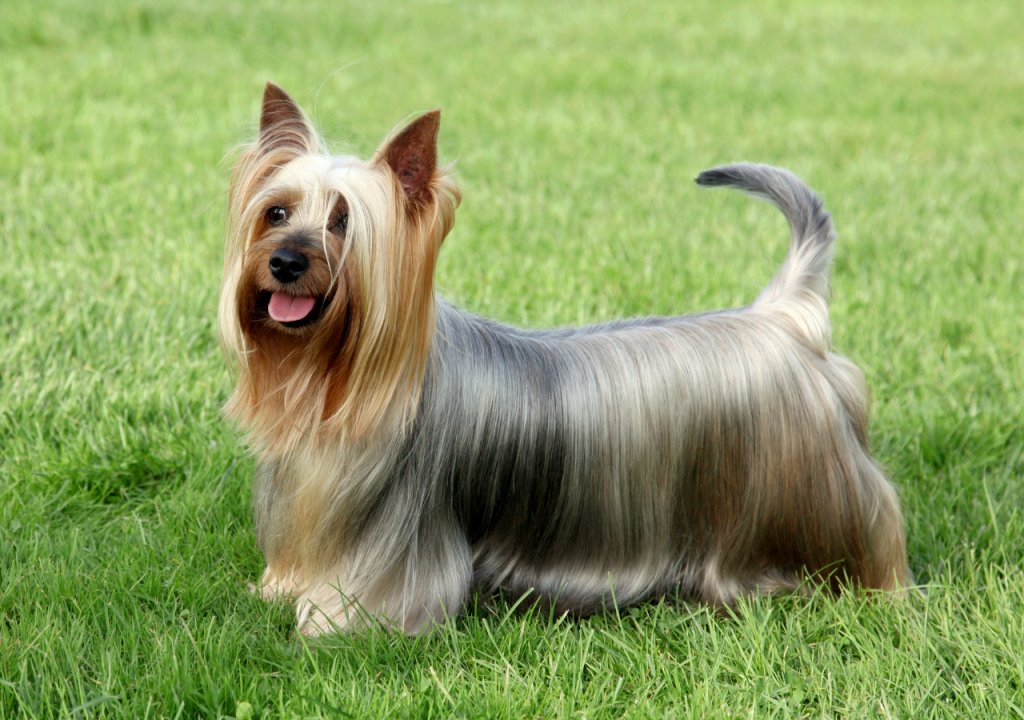
Aussie Type
The influence of the Australian Terrier on the Silky Terrier is profound and represents a significant part of the breed’s lineage. The Silky Terrier was developed to embody the robustness of the Australian Terrier, coupled with the fine coat of the Yorkshire Terrier, creating a breed that, as Males succinctly puts it, is “more Australian Terrier than Yorkshire Terrier—except for the coat.” This breeding intent has given the Silky Terrier a distinctive physical and temperamental edge that leans more towards the Aussie Terrier, especially in terms of its size, structure, and spirited personality, distinguishing it from the more diminutive Yorkie.
The development of the Silky Terrier’s unique coat and personality traits is a testament to the breed’s intricate history. According to the AKC, Linda Gross, another breeder, recounts her enchantment upon first encountering the breed’s distinctive coat: liquid silver tipped in black, rich browns, and golden tans—a palette that mesmerized her and highlighted the breed’s unique appeal. This encounter underscores the breed’s captivating beauty and the tactile pleasure of its cool, silky coat, which bears a resemblance to human hair, thus earning the breed its name.
The Silky Terrier stands as a unique breed, embodying the best of both worlds: the elegant coat reminiscent of the Yorkshire Terrier and the robust vitality of the Australian Terrier. This combination has resulted in a breed that, while often requiring clarification to those less familiar, holds a distinct and cherished place in the canine kingdom. Through the efforts of breeders and enthusiasts, the Silky Terrier continues to be celebrated for its unique heritage and captivating characteristics, distinct from its Yorkshire and Australian ancestors.
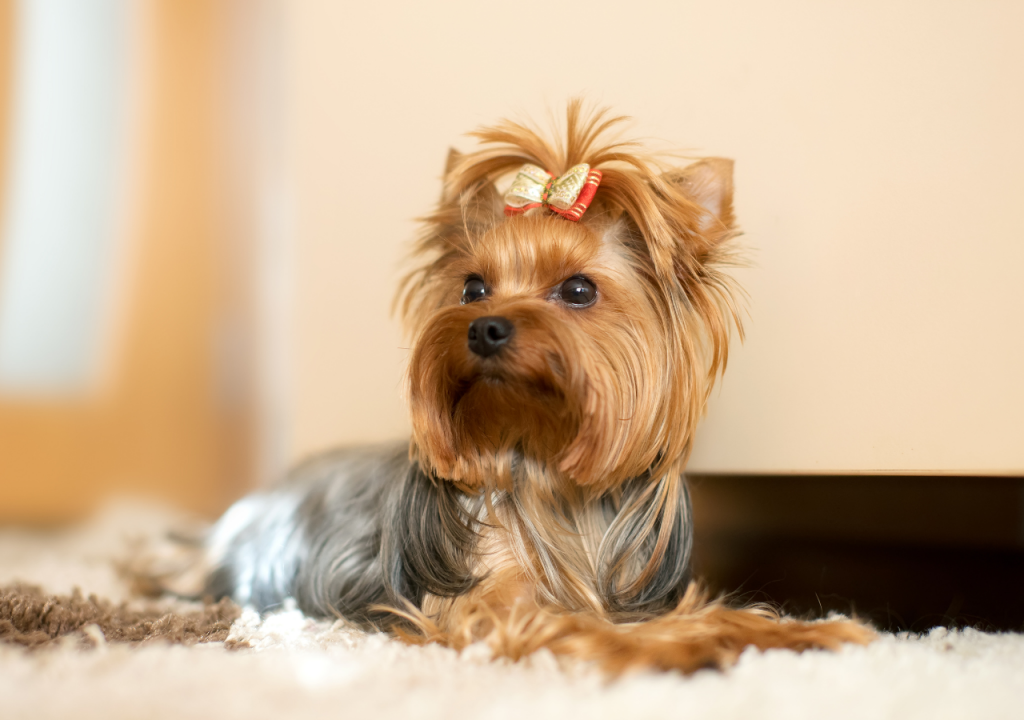
Differences Between Silky Terriers and Yorkshire Terriers
Size and Appearance
While both breeds share a similar color palette, the Silky’s coat is more prone to tangling and requires frequent grooming to maintain its luster. Yorkies, though also high-maintenance in the grooming department, have a finer hair texture. Size-wise, the Silky is slightly larger, a distinction that can affect living arrangements and care.
Temperament and Personality
Silkies are known for their adventurous spirit and confident demeanor, often described as having a “big dog personality” in a small dog’s body. They are fiercely loyal and can be more vocal. Yorkies, while also spirited, tend to have a more affectionate and dependent nature, thriving on human companionship.
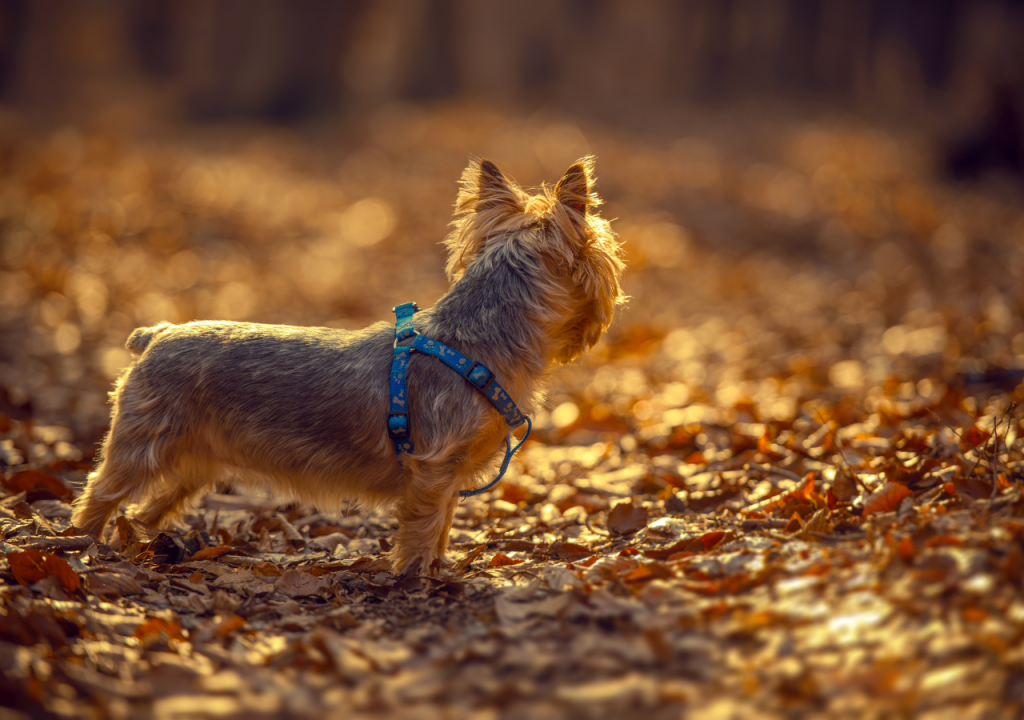
Silky Terrier Vs Yorkshire terrier: Grooming and Care
Grooming Needs
The Silky’s coat requires regular brushing to prevent mats, while the Yorkie’s fine hair might demand professional grooming to maintain its trademark appearance. Both breeds need routine care, including ear cleaning and nail trimming.
Exercise Requirements
Despite their small size, both breeds have a surprising amount of energy. Silkies might need slightly more vigorous exercise to satisfy their adventurous streak, whereas Yorkies are content with shorter, more frequent walks.
Yorkshire terrier Vs Silky Terrier: Health and Lifespan
When comparing the lifespan of Silky Terriers and Yorkshire Terriers, both breeds are known for their longevity, often living well into their teens with proper care. On average, the lifespan of a Silky Terrier ranges from 12 to 15 years, while a Yorkshire Terrier’s lifespan is similarly between 13 and 16 years. These estimates can vary based on factors such as genetics, health care, diet, and overall lifestyle.
Both breeds are relatively healthy, but like all dogs, they can be prone to certain health conditions that may impact their lifespan. Common issues for both the Silky Terrier and Yorkshire Terrier include dental problems, due to their small jaws, and patellar luxation, which affects the knee joint. Ensuring regular veterinary check-ups, maintaining a healthy diet, providing regular exercise, and keeping up with dental hygiene can help maximize their lifespan.
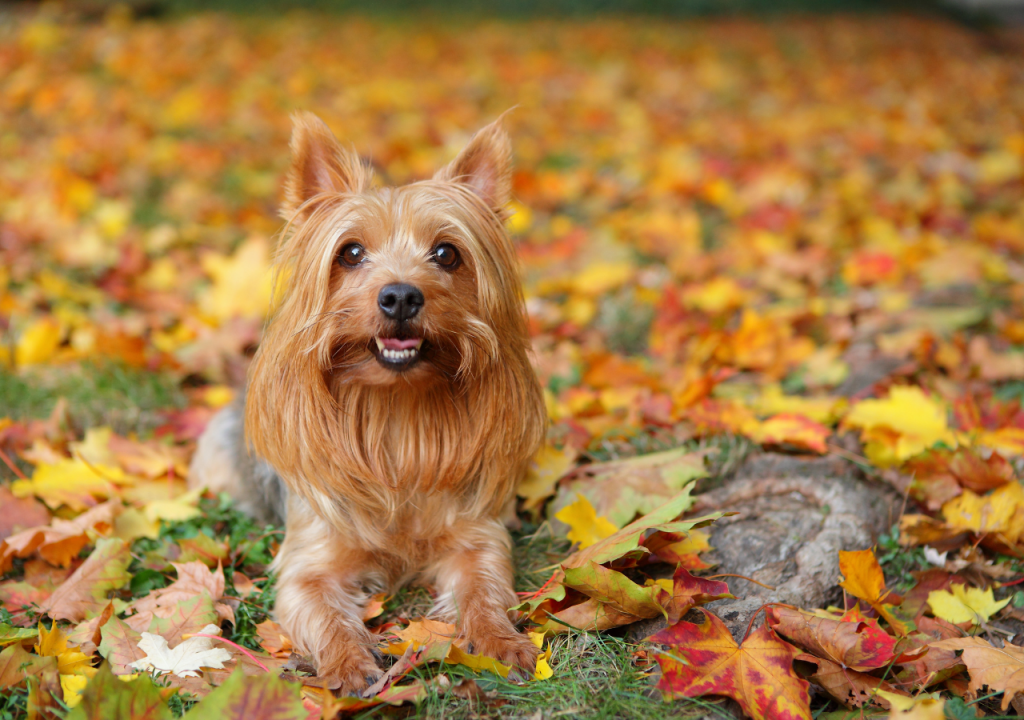
To prevent your Yorkie or Silky Terrier from dental issues, it’s important to take your pooch to the vet every six months. In that way, you can notice some dental issues at the very beginning. Yorkies are prone to suffering from overcrowded teeth and periodontosis.
Although it’s a health issue characteristic for these breeds, you can prevent it by feeding your Yorkie with a healthy diet. A well-balanced diet for Yorkies or Silky terriers should be free of additives, artificial colors, and flavors. Besides, regular teeth brushing can also prevent dental problems in these 2 breeds.
Use a dog tooth paste because it’s carefully made to suit their sensitive gums. Aside from tooth brushing, giving your dog to play with toys is also important. Chewing will help your pet to develop a strong jaw and teeth. Squeaky Training Interactive Dog Toy can be one of the picks to keep your dog’s teeth clean and free from calculus.
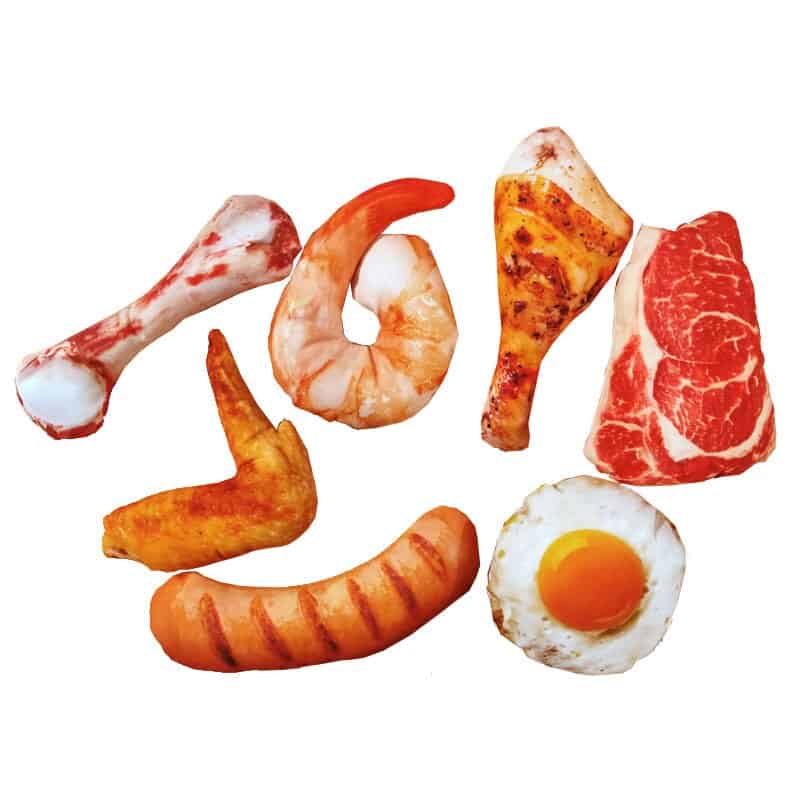
Silky terrier Vs Yorkshire terrier: Training and Socialization
Training Tips
Training a Silky or Yorkie can be a rewarding endeavor, given their intelligence and eagerness to please. Consistency and positive reinforcement are key, with early socialization to curb any potential for overprotectiveness or shyness.
Socialization Needs
Both breeds benefit from early exposure to various people, pets, and situations, fostering a well-rounded temperament. Silkies, in particular, may require more effort to mitigate their natural wariness of strangers.
Silky Terrier Vs Yorkshire Terrier: Choosing the Right Breed for You
Lifestyle Compatibility
Considering your lifestyle is crucial when choosing between a Silky and Yorkie. Active individuals or families might find the Silky’s robust nature a better fit, while those seeking a more cuddly, less demanding companion may lean towards the Yorkie.
Comparing Silky terrier vs Yorkie terrier, we can say that both breeds are friendly toward children. However, socialization of a dog also plays and important role. If you didn’t introduce your Yorkie or Silky terrier puppy with other pets and children and people, then you can’t expect he/she will behave friendly from the first meeting.
Every dog should get a dose of socialization from his/her young age. When a dog get used to spending time with other animals and people, he/she will be less prone to aggression and unpredictable acts.
Both breeds can thrive in apartment settings, provided their exercise needs are met. Families with young children should note that Silkies and Yorkies, due to their small size, require gentle handling to prevent injury.
Since both breeds are small and tiny, choosing the right bed for them also plays an important role. In case you don’t know how to pick the right one for your pooch, then we recommend you to read our blog post on how to choose the bed for your Yorkie.
Activity Level and Exercise Needs of Yorkies and Silkies
Matching your activity level to your pet’s needs is essential. Both breeds will enjoy being part of your daily activities, whether it’s a brisk walk for the Silky or a cozy lap nap for the Yorkie.
Comparing Silky terrier vs Yorkshire terrier, we can tell that Silkies have higher energy levels. Therefore, if you’re a fan of outdoor adventures with your furry friend, then Silky can be the right fit for you. They require more daily activities to become ‘’pleasantly tired’’.
To keep your furry friend engaged, we recommend you to check our collection of Yorkie toys.
Interactive Yorkie Pal Toy release sound, and it will make your pet curious and engaged during play.
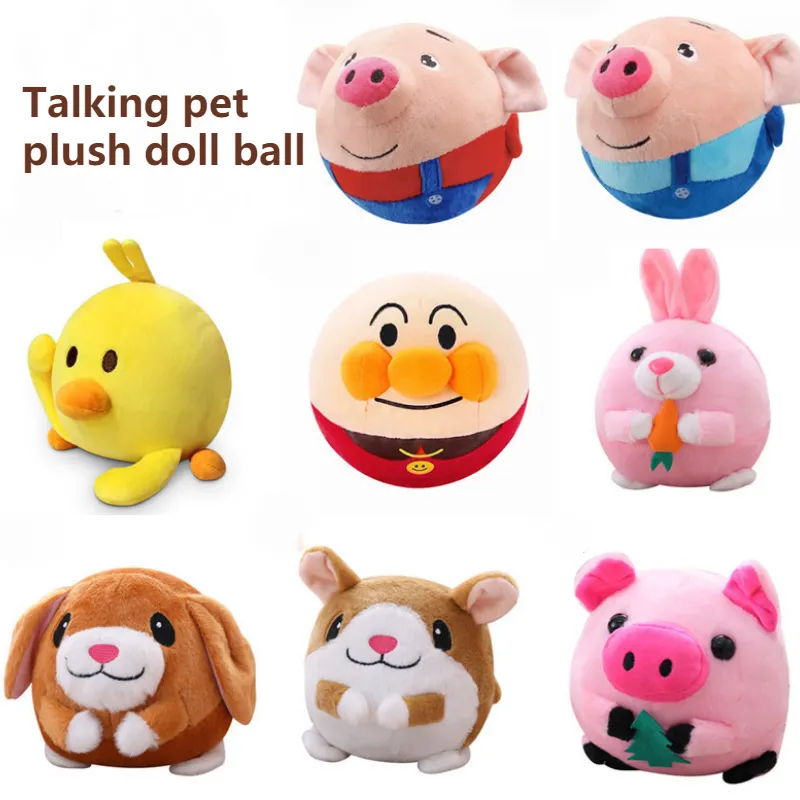
Silky Terrier or Yorkshire terrier: Making the Decision
The decision between a Silky Terrier and a Yorkshire Terrier is a personal one, influenced by factors such as lifestyle, family dynamics, and individual preferences for grooming and care. By carefully considering these aspects, you’re sure to find a furry friend that not only captures your heart but fits seamlessly into your life. Whether you’re drawn to the spirited and robust Silky or the affectionate and dainty Yorkie, understanding their unique characteristics will ensure a harmonious match that enriches your life for years to come.

